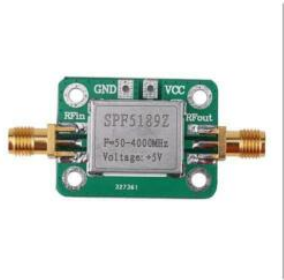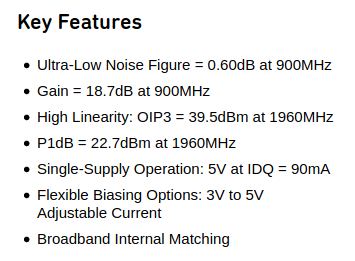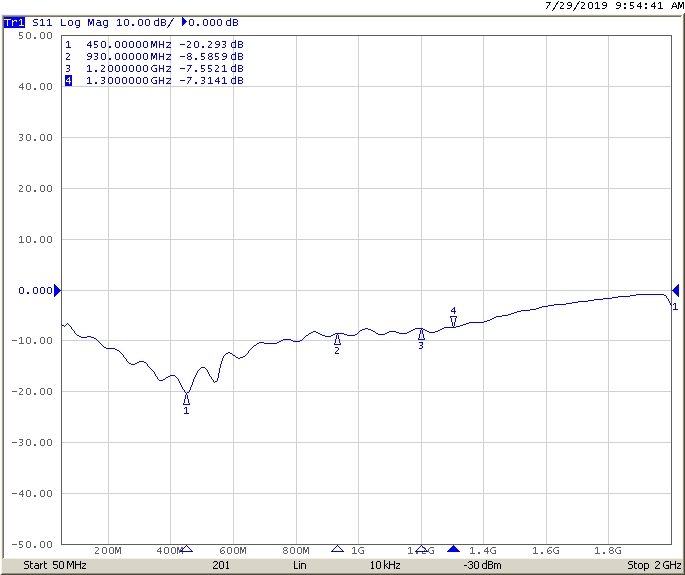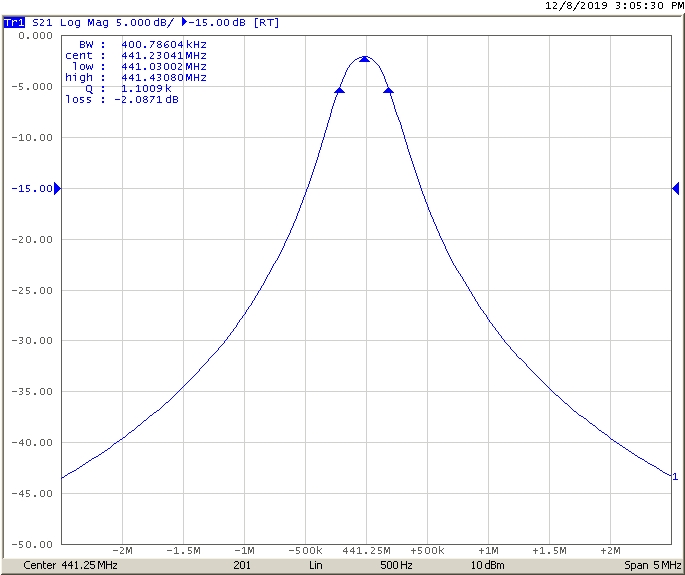The Qorvo SPF5189Z based RF gain block modules being sold on Ebay for about 5 dollars shipped, offer an excellent value for building a low cost VHF or UHF preamp without sacrificing performance.
These are sold as a small double sided PCB with female SMA connectors installed. The bottom of the board is a continuous ground plane and the top side has a small tin plated shield over the RF circuitry. They require only a single +5 volt supply at about 100 milliamps for operation. The active device is the SPF5189Z which is a GaAs pHEMT low noise MMIC amplifier.

The specs for this device are very impressive for it’s price point. We can thank the cell phone industry for high performance, high volume (cheap) parts like this. The MMIC is rated for gain from 50-4000 MHz. At 70cm the gain is about 20+ dB and at 450 MHz. the noise figure less than 0.5 dB. A quick summary of the SPF5189Z is below:

These specs are very similar to to the highly rated and more expensive PGA103+ amplifier MMIC from Minicircuits. It has been the part used in many high quality Ham preamps being sold today.
The down side of these modules is they are broad-band, untuned circuits, and require filtering and/or additional shielding in high RF environments.
The preamp employed on the new K7EVR repeater is build with one of these modules. It was mounted in a small Pomona size B diecast shielded box with robust M/F type N connectors installed. The SMA connectors were removed and short heavy gauge wire ran from the RF in/out on the PCB to the N center pins. These leads ended up being about 10 mm long, and significantly degraded the input return loss of the preamp over 1 GHz.

As can be seen, RL is about 20 dB at 450, but gets worse from there. The bottom side of the board is grounded to the case and additional ground paths to the SMA shield points are provided. This is OK for 450 MHz; not OK much higher in frequency, with the added inductance. It was just luck that in this case, the minimum SWR was near the desired operating frequency. Clearly, a better remounting arrangement is needed for microwave frequencies. Still, compared to the average GaAs FET preamp with it’s typically poor in-looking RL, the input VSWR of this MMIC is great. No complaints..

Input filtering to the preamp used on the repeater is furnished by two series connected six inch diameter cavities that provide a 3 dB bandwidth of about 400 KHz. This also adds about 40 dB more TX isolation to the 110 dB notch provided by the duplexer. At these levels, shielding is everything in order to actually achieve isolation close to this magnitude. In this case, the preamp’s N connector screws directly to the output of the cavity filter, and the two cavities and RX interconnect are Superflex FSJ1. No RF adapters are used, and all N connectors are tightened with a wrench. BNC connectors here would be a compromise; most types provide only 70-80 dB of isolation at 500 MHz. This RF leakage is related to the poorer ground retention of the bayonet lock vs a screw thread. High quality silver N, TNC and gold SMA connectors can provide greater than 100 dB isolation at 500 MHz, if properly installed. That degree of isolation is rarely required, but the input of an unfiltered high gain preamp in a high RF environment is one such place.
DIN 7/16 connectors would be better still. They have the advantages of very low leakage/high isolation and exceptionally low PIM, but are expensive. There are a couple of very nice mini versions of the 50 ohm DIN connector that measures 4.1/9.5 and 4.3/10mm, also have great specs, are somewhat less expensive, and would be an excellent choice for this type of application.

In the current repeater configuration, the goal was to just supplement the excellent front-end of the Hytera repeater in a heavy RF milieu with enough gain to overcome the losses of the duplexer, RX cavities and feedline. So currently, a 10 dB type N attenuator is installed between the output of the preamp and the RX input of the repeater. With about 22 dB of preamp gain, this setup yields about 7-8 dB RX gain over the sum of incurred losses. The estimated overall system frontend noise figure should be about 6.3 dB. Derived as 1.6 (feedline) + 2.0 (filter) + 1.2 (duplexer) + 0.5 (preamp) + 1.0 (Hytera RX_FE). This calculation really brings home the NF advantages of a separate RX antenna with the preamp mounted very near the antenna. Unfortunately, this just isn’t practical at most radio sites.
In summary, I have found these preamp modules to be a great bargain. Their construction quality and performance is surprising good even at several times the price. Besides use as a preamp, they can be used for general purpose RF gain blocks over a wide frequency range.
Dave, K7DMK